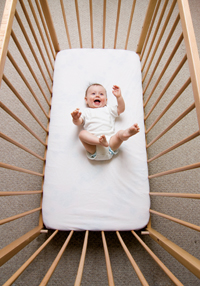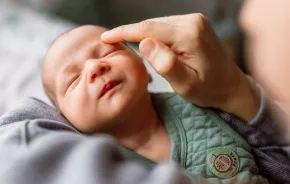Babies and toddlers are wonderful, but they come with a lot of stuff. You can keep it from taking over your house with just a little advance planning, creativity and yes, organization.
 Step one: Evaluate
Step one: Evaluate
According to Julie Morgenstern, author of the bestselling book Organizing from the Inside Out, the secret to successful organization is creating a system based on you: your needs, goals and personality. This means you have to spend some time thinking before you go out and splurge on those cool stacker/organizers. Start by evaluating your space. How big is it? What are its limits? If the crib you have will only fit in one corner, that will, obviously, affect your options. Try sketching out the space on graph paper to get an idea of what you have to work with.
Next, think about organization. Morgenstern recommends using what she calls the “Kindergarten Model,” her secret weapon for getting — and keeping — a space organized. Using this model, you divide the room into separate “activity zones,” each of which will contain all you need for that activity. Because everything is stored where it is used, it is far easier to put things away as you go. And because you are thinking it out in advance, you can work out a place for everything you will need.
Step two: Decide
For parents who have already had babies, figuring out “activity zones” may be fairly easy. With our first child, we bought a fancy dresser with a changing-table top and placed it next to our baby’s matching crib. Within two days of bringing our baby home, however, we realized that we were not going to lug the baby all the way upstairs to change a diaper every hour when we were so tired we could barely stand up. We quickly set up a changing station downstairs, which fit much better with our personalities and needs. This time around, we’re using our previous experience with what worked — and didn’t — in setting up for our new baby. If this is your first time with a baby, try planning those zones around the main activities of baby rearing: changing diapers, feeding, dressing, sleeping, playing and reading.
Part of deciding where to put each zone is figuring out about how much stuff each zone will need. As you no doubt have noticed, there are a plenitude of products and choices available. Luckily, there are also several no-nonsense guides that will help you decide what you really need (see Resources, below). Family and friends may have good advice, and you can safely start with the minimum number of items most sources recommend: a crib, a changing table and/or dresser, rocker/glider and soft lighting. For my family, a bookcase was among the necessities (secured to the wall with protective straps). We also got a lot of use out of a laundry hamper and diaper pail, and we set up a separate basket in which to throw the daily toys, as well as a space on the bookshelf for all of the baby’s health records.
Also remember to think about what you will need. For example, once your baby is crawling and playing on the floor, you will be down there, too, so have some pillows you can sit on. Baby blankets are fine, but consider having a larger blanket to keep you warm during nursing. You might also want a table next to the feeding zone where you can have books or beverages to sip while the baby enjoys a bottle or breast.
Step three: Be ready for change
Before your child was born, you likely bought or were given things for babyhood’s several different stages. Rather than having those things stuffed in the drawers next to the items you can actually use now, think about having a “soon” box — a box filled with toys and clothes one size or developmental level above your child’s current age. If you have a closet, mark the outside of the box and tuck it in where it will be easy to reach, but out of the way. Or you can get a decorative box with a lid from a craft store and keep it on a shelf. For all the things your child grows out of, try the reverse: a box or basket in which you can toss whatever you no longer use. Later, you can sort through and choose what to save, pass on or donate.
Above all, organization is about what works for you. If you notice something is not working, change it! Staying flexible and keeping your sense of humor will help you enjoy these important years with a minimum of fuss and a maximum of fun.
Kathryn Russell Selk lives, works and writes in Seattle. She’s currently figuring out the zones for the new baby’s room with her husband and 5-year-old, Kiernan.
Resources: What do you really need?
Skip the long lists handed out by baby stuff suppliers and check out these resources designed to help you make more reasonable decisions:
The Girlfriends' Guide to Baby Gear by Vicki Iovine (another in the very accessible, fun “Girlfriends' Guide” series)
The Baby Gizmo Buying Guide by Heather Maclean (from the “mom editors” of BabyGizmo.com)
Parents Baby Gear from Birth to Age Three by Debra Wise (from the editors of Parents Magazine)
If you have hand-me-downs or borrowed items for your 0– to 2-year-old (or any age), be sure to check for recalls at the Consumer Product Safety Commission Web site (click on “recalls and product safety news” to search by product type).
Safety issue: crib bumpers
A crib “bumper” is a soft, padded fabric that is usually tied around the bottom part of the baby’s crib, just above the mattress. Bumpers were introduced years ago when the slats in crib railings were much farther apart and there was a concern that a baby’s head could get stuck without some protection, or that a baby might injure itself by rolling its head against the sides of the crib.
Some reports, however, cast serious doubt about the safety of bumpers. In 2005, a task force on sudden infant death syndrome (SIDS) concluded that even very firm bumper pads can pose a serious risk of strangulation and suffocation. The American Academy of Pediatrics and the Consumer Products Safety Commission are among the groups now recommending against using “pillow-like” bumper pads, while Health Canada and some SIDS organizations go further and recommend that no bumper pads should ever be used.











